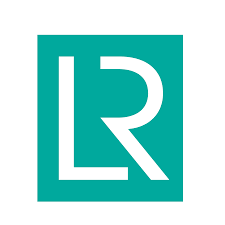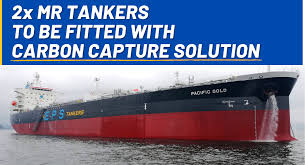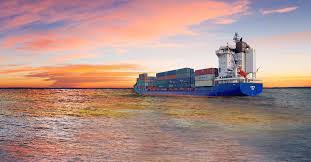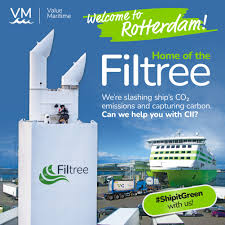On August 27, 2024, Lloyd’s Register (LR) announced that it has issued its first class approval for an onboard carbon capture system on the “Pacific Cobalt,” a 49,700 deadweight ton MR (medium range) tanker owned by Eastern Pacific Shipping (EPS). The vessel, built by Onomichi Dockyard in 2020, has been retrofitted with a prefabricated Onboard Carbon Capture & Storage (OCCS) system developed by Value Maritime, a company based in the Netherlands. This system will significantly reduce the emissions from the ship’s exhaust gases. This marks the first time LR has granted class approval for an OCCS on a medium-range tanker.
(Text by Hiro Yamamoto)
Photo courtesy = LR, EPS, Value Maritime

The Emission Abatement Carbon Capture & Storage (EACCS) system, certified by Lloyd’s Register (LR), ensures the reliability of safety risk assessments and solutions related to the installation of onboard carbon capture and storage (OCCS) systems. LR’s class approval for the EACCS includes regulatory requirements concerning the design, construction, and installation surveys of the OCCS.
LR’s new class approval requirements cover various safety risks to the vessel and address aspects such as materials, structures, containment, piping, refrigeration equipment, electrical and control systems, safety systems, ship integration, and manufacturing.

The Filtree OCCS system, developed by Value Maritime (see the reference in the Word section at the end of this article), can remove and capture up to 40% of carbon dioxide (CO2) from exhaust gases, with the captured CO2 being stored onboard according to the storage tank capacity. While carbon capture and storage (CCS) technology is well-established onshore, the application of OCCS for ships has gained attention recently as a viable short- to mid-term solution to meet the International Maritime Organization (IMO) emission reduction targets.
■Nick Brown, LR CEO, said: “This class notation for an OCCS is the first for Lloyd’s Register and the first for a vessel of this size. Eastern Pacific Shipping is a pioneer in onboard CCS and this installation demonstrates its commitment to reducing emissions in its operations in line with IMO ambitions. This class notation will further support OCCS installations on ships giving industry confidence in the technology’s ability to support shipping’s decarbonisation goals.”
■Cyril Ducau, Chief Executive Officer, of Eastern Pacific Shipping, said: “Pacific Cobalt’s retrofit with Value Maritime’s exhaust cleaning and Carbon Capture System was an important milestone in EPS’s sustainable shipping journey. Our partnership with LR and Value Maritime showcases a collective commitment to achieving the industry’s emissions reduction targets, decarbonizing shipping.”
■Jurriaan Guljé, Operations Director, Value Maritime, said: “The combined commitment and engineering expertise of EPS, LR, and Value Maritime have made onboard carbon capture a reality, paving the way for OCCS technology to significantly contribute to sustainable maritime operations. The issuance of the very first LR class notation for onboard carbon capture is huge for our industry. The Pacific Cobalt now leads by example, demonstrating that sustainable shipping is here to stay.”

■Value Maritime’s Filtree System
The Filtree system is a combination of a SOx (sulfur oxides) exhaust gas scrubbing system and CO2 capture. This system can remove up to 99.9% of sulfur oxides and 99% of particulate matter from exhaust gases using seawater. The remaining gases, primarily CO2, then enter the OCCS system, where they come into contact with a chemical substance called amine as they rise.
The low temperature of the exhaust gases causes some of the CO2 to bind to the amine particles. This compound, while remaining in a gaseous state, behaves like a liquid and is pumped into storage tanks. Since the CO2 is not liquefied or pressurized, the system significantly reduces energy costs for capture and storage.
The amine saturated with CO2 is discharged from the vessel when it is docked in port and is replaced with fresh amine. Lloyd’s Register granted an Approval in Principle (AiP) for the Filtree system in September 2022.
〆英ロイド・レジスター(Lloyd’s Register)はEPS(Eastern Pacific Shipping)のMR(midium range)型タンカーの船上炭素回収に対し初のクラス認定を発行した。
英ロイド船級協会(LR)は2024年8月27日、イースタン・パシフィック・シッピング(EPS)が所有する4万9700重量㌧のMR型タンカー、「パシフィック・コバルト」(尾道造船で2020年に竣工)の船上炭素回収に対し初めてクラス認定を発行したと発表した。「パシフィック・コバルト」はオランダのバリュー・マリタイムの組み立て式の船上炭素回収・貯留(a prefabricated Onboard Carbon Capture & Storage、OCCS)システムをレトロフィットし、排気ガスの排出量を大幅に削減することが可能になる。LRが中型タンカーのOCCSにクラス認定を発行するのは初めて。
(Text by Hiro Yamamoto)
Photo courtesy=LR, EPS, Value Maritime
LRがクラス認証を発行した「排出ガス削減・炭素回収・貯留(The Emission Abatement Carbon Capture & Storage、EACCS)(アミン、HFO)」は、OCCS設置に関連する安全リスク、解決策に信頼性があることを保証する。EACSSに対するLRのクラス認定には、OCCSの設計、建設、設置調査に関する規則要件が含まれる。
LRの新たなクラス認定の要件は、船に対する安全リスクをカバーし、材料、構造、格納、配管、冷凍設備、電気、制御、安全システム、船舶統合、製造などの側面を網羅する。
今回、バリュー・マリタイム(Value Maritime) が開発したFiltree OCCSシステム(記事の最後にあるワード欄を参照して下さい)は、排気ガスから最大40%の二酸化炭素(CO2)を除去し、回収することが可能で、船上の貯蔵タンクの容量に応じて貯蔵することができる。
CCSは陸上で確立された技術である半面、船舶用のOCCSは近年になり、IMO(国際海事機関)の排出削減目標を達成するための実行可能な短期から中期の経路として注目されている。
今回のクラス認証についてLRのニック・ブラウン(Nick Brown)CEO(最高経営責任者)は「このOCCSのクラス認定は、LRにとっても、またこのサイズの船舶にとっても初めてのものだ。EPSは、船上CCSの先駆者であり、この設置はIMOの目標に沿った排出削減に対するコミットメントを示している。今回のLRのクラス認定は、船舶へのOCCS設置をさらに支援し、業界に対して技術の信頼性を提供し、海運業の脱炭素化目標を支えることになる」とコメントした。
一方、EPSのシリル・ドゥカウ(Cyril Ducau )CEOは、「パシフィック・コバルトに搭載したバリュー・マリタイムの排気ガス浄化および炭素回収システムのレトロフィットは、EPSの持続可能な海運の旅における重要な位置づけになった。LR、バリュー・マリタイムとのパートナーシップは、業界の排出削減目標を達成し、海運の脱炭素化を実現するための集団的なコミットメントになる」と説明した。
バリュー・マリタイムの運用ディレクター、ユリアン・グリジェ(Jurriaan Guljé)氏は、「EPS、LR、バリュー・マリタイムの結合されたコミットメントとエンジニアリングの専門知識により、船上炭素回収が現実のものとなり、OCCS技術が持続可能な海上運用に大いに貢献する道を切り開いた。船上炭素回収に対する初のLRクラス認定の発行は、業界にとって大きな進展である。パシフィック・コバルトは、持続可能な海運が確立されていることを示す手本となるだろう」と述べた。
■ワード
バリュー・マリタイム、フィルトリーシステム
フィルトリーシステムは、Sox(硫黄酸化物)排気ガス洗浄システムとCO2回収を組み合わせたもの。このシステムは、海水を使用して排気ガスから99.9%の硫黄酸化物と99%の粒子状物質を除去することが可能になる。その後、残りのガス(主にCO2)はOCCSシステムに入り、上昇する際に化学物質であるアミンと接触する。
排気ガスの低温により、CO2の一部がアミン粒子に結合する。この化合物はガス状態のままだが、液体のようになり、貯蔵タンクにポンプで送られる。CO2は液化されず、加圧もされないため、回収と貯蔵のためのエネルギーコストを削減することが可能になる。
CO2で飽和したアミンは、港湾に停泊した際に船外に排出され、新しいアミンと交換される。LRは22年9月にフィルトリーシステムに対して原則承認(AiP)を与えた。
